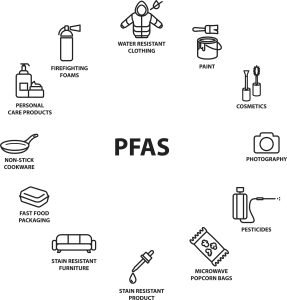Forever Chemicals

In the 1930’s, PFAS or forever chemicals, seemed like a great idea. Formally known as per-and polyfluoroalkyl substances, PFAS are a group of chemicals that are used in the creation of coatings and products that resist stains, great, heat, and water. Today, most households have clothing, furniture, pots and pans, electrical wire, or any number of other products that contain PFAS. Even food packaging from restaurants and on most grocery store shelves, and subsequently most kitchens, contain PFAS.
9,000 Plus
Again, initially these products seemed like great steps forward. It wasn’t until time revealed that PFAS do not break down in the environment that these products began to be scrutinized. By then, it was too late. it was found that these forever chemicals are capable of moving through soil and contaminating drinking water sources. That meant that they not only build up in fish and wildlife, but in humans as well.
Not visible to the human eye, there are nearly 9,000 different synthetic chemicals that are considered PFAS. By the time the public realized how pervasive these chemicals were – easily getting to and into humans through the air, dust, food, soil, and water – society was also realizing the adverse health impacts associated with PFAS exposure. These adverse health impacts include liver damage, thyroid disease, decreased fertility, high cholesterol, obesity, hormone suppression, and cancer – just to name a few. PFAS have been found in blood and mother’s milk.
Not Forever
The good news is that scientists are working on ways to capture and remove these forever chemicals. It’s neither simple nor quick, but there are methods being pursued. Removing them from water will be a big start to getting rid of these forever chemicals…forever.
In the meantime, limit your exposure. Have your drinking water tested. If PFAS in your drinking water are an issue, consider an in-home water purifier that will remove the particles. Remember, in addition to drinking, you cook with brush your teeth with, and shower with the same water, to name just a few ways you are potentially exposed to PFAS through your water.
Additionally, avoid fast food wrappers and remove all food from packaging before reheating to limit PFAS exposure. Some restaurants do not use packaging with PFAS. Find out if your favorite restaurant does and ask them not to.
PFAS are found in many products you no doubt have in your home. Carpets, furniture, personal care products, cookware, clothing, and shoes are just some of the everyday products that can contain PFAS. When making a new purchase favor manufacturers and retailers that have policies restricting the use of PFAS. Find a list of PFAS free products, and lots of other information, at pfascentral.org.
Everything Helpful Isn’t Good
Today, we are living with the PFAS proof that everything helpful isn’t good for our health. Find out what your options are when it comes to chemical exposure. Make the choices that will help you and your family live 100:100, a long and healthy life for 100 years or more. Your lifespan might not be “forever,” but at 100 Year Lifestyle we want you to be healthy from your first to last breath. Find a 100 Year Lifestyle provider to help you achieve that healthy goal!
- SHARE THIS POST







